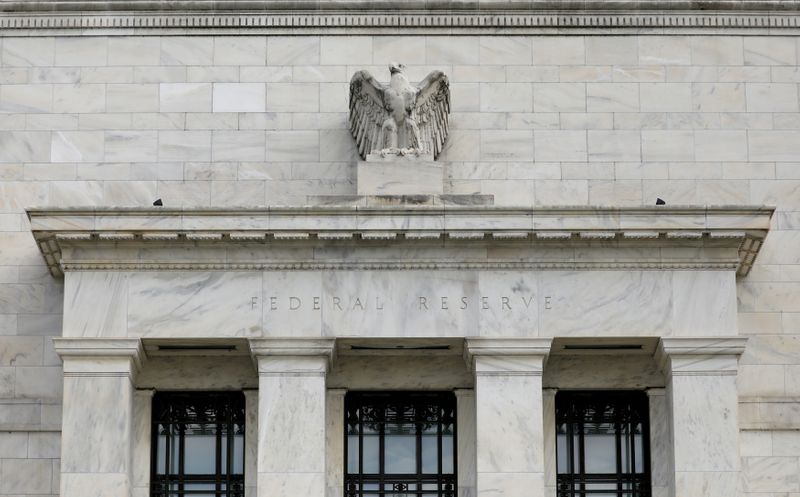(This March 10 story clarifies name of asset manager in para 9)
LONDON (Reuters) – Rising Treasury yields, a dollar rebound and commodity prices at multi-year highs may be starting to feed into a tightening of global financial conditions, testing the resolve of central bankers to reverse the moves by providing additional support.
Financial conditions is the umbrella phrase for how exchange rates, borrowing costs, and equity swings affect the economy. Measuring them is an inexact science, but a range of indexes, or FCIs, exist to gauge day-to-day changes.
How loose or tight financial conditions are dictate the spending, saving and investment plans of businesses and households. Goldman Sachs says its index – one of the most widely used – has a strong historical correlation with growth.
A 100-basis-point tightening in conditions on its index crimps growth by one percentage point in the coming year or vice versa, Goldman has shown in the past.
Such indexes and those compiled by the U.S. Federal Reserve, currently show two things: conditions are indeed grinding tighter but they also remain near the easiest on record.
That may explain why the Fed does not seem inclined to counter the 60-basis-point year-to-date rise in Treasury yields.
Fed Chairman Jerome Powell’s choice of words — that he “would be concerned by a persistent tightening in financial conditions” — show he is comfortable with current levels, Natwest points out.
Of the components comprising FCIs, the dollar and 10-year bond yields have risen this year.
But yield spreads on corporate bonds haven’t budged much from end-2020 levels. Equities, with the exception of rate-sensitive tech shares, are broadly flat. Short-dated interest rates are rock-steady, noted Jim Caron, head of global macro strategies at Morgan Stanley Investment Management.
“I would not say this rise in yields has done anything to materially tighten U.S. financial conditions … As long as 10-year real yields (interest rates minus the rate of inflation) are at -0.6%, I’d say there is still a lot of accommodation,” Caron said.
“The Fed is looking at all that and saying, ‘Ok, so far this rise in rates isn’t really hurting broader markets and the economy’.”
Dovish Fed pivots in recent years — following the 2013 taper tantrum, late 2018 and last March — all happened when Goldman’s U.S. FCI spiked above 100 points. It now sits just below 98 points:
Graphic: U.S. financial conditions index- https://graphics.reuters.com/GLOBAL-MARKETS/CONDITIONS/jbyvraogype/chart.png
EURO FIGHTERS
The European Central Bank has more reason for alarm. In contrast to the United States, euro area economic recovery is underwhelming — the European Commission now expects 2021 growth at 3.8% versus a previous 4.2%.
Yet German yields, the risk-free euro area reference rate, have risen 30 bps since early 2021 and monetary conditions are tightening:
Graphic: Tighter monetary conditions in Europe – https://fingfx.thomsonreuters.com/gfx/mkt/qzjvqgxwzvx/monetaryconditions.PNG
ECB officials are vocal in advocating action — board member Fabio Panetta said higher yields were “unwelcome and must be resisted”. The ECB is expected to up bond-buying via its PEPP stimulus scheme to tamp down yields.
While the ECB’s Jan. 21 meeting described financial conditions as “appropriate”, bond yields have risen since then and bank lending standards have tightened, says AXA chief economist Gilles Moec.
“This is the point (at which) the ECB should be reacting,” Moec said. His recommendation? “You accelerate the PEPP and you say that you are doing it!”
Many argue the Fed should be acting now, too, before conditions tighten to 2013 or even 2018 levels as the recent explosion in debt levels has made the U.S. and world economies more sensitive to such changes.
The Fed will be cognizant too that European conditions will eventually drag on the global recovery.
Developing economies saw their financial conditions tighten significantly last year as COVID shut some borrowing markets completely. Things had been getting a bit easier again, Institute of International Finance surveys suggest, but are still way harder than pre-pandemic and will worsen again if rates rise.
Finally, market moves have a habit of overshooting.
“I don’t think policymakers are worried about the level (of financial conditions) at the moment,” said Dirk Schmacher at Natixis. “They are worried, and rightly so, about where it stops.”
Graphic: Financial conditions across emerging markets – https://graphics.reuters.com/MARKETS-FINANCIALCONDITIONS/bdwpkmgjkpm/chart.png
(Reporting by Marc Jones and Sujata Rao, editing by Larry King)






















